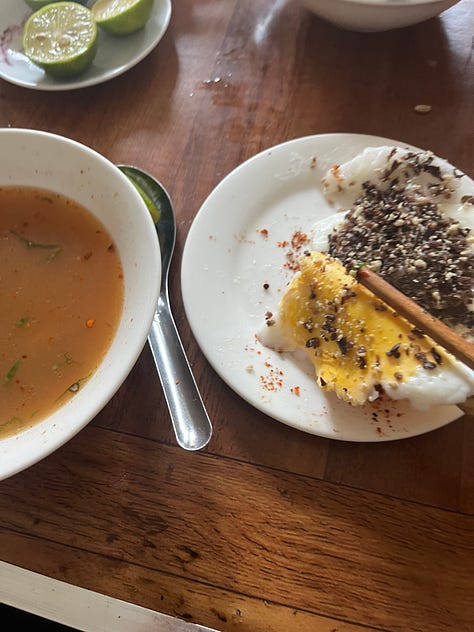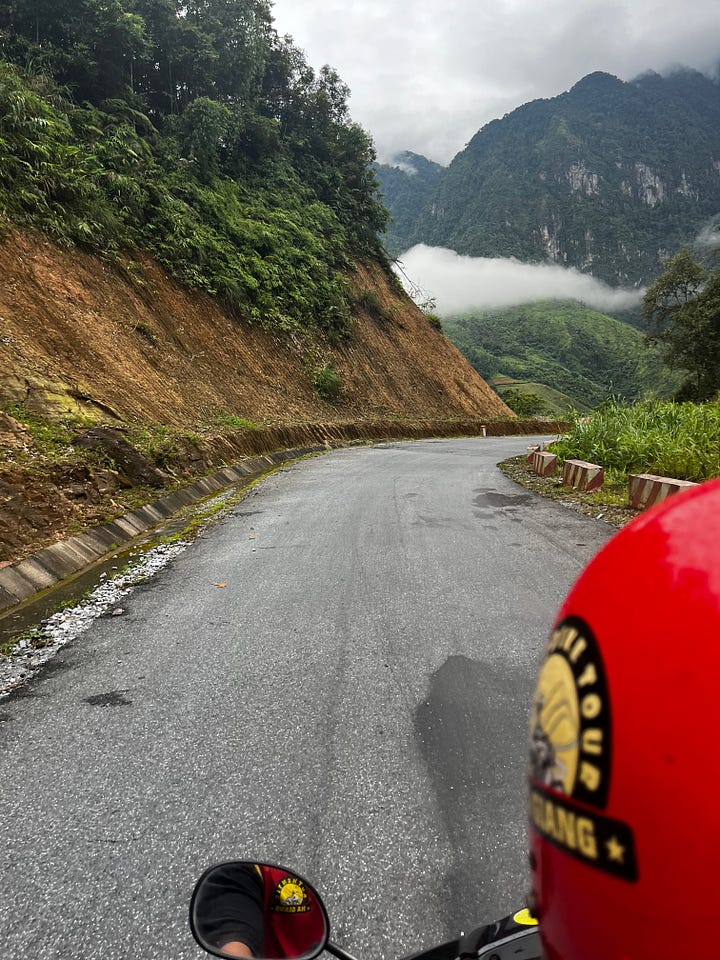the Ha Giang loop, day two: coffee in a cloud
landslides, Hmong village homefires, & Hmong King Palace
Thanks for visiting Narrative Nation!
I returned to Vietnam for a solo adventure after walking the streets in my mind so many times since I visited with the family in 2019. This trip included the capital city Hà Nội; a homestay by Sông Lô (the Lô River) in Hà Giang, the country’s northernmost province bordering China; and a two-day motorbike ride on the famous Hà Giang loop. Because this is such a fascinating and exciting place, and because there is so much interesting patriotic and nationalist art and public history to consider in Hà Nội, I decided to share some photos and short videos with a few explanations here. You can follow this series from the beginning here. Enjoy!
This post picks up the second part of my two-day motorcycle ride through the Hà Giang loop, which is not one path but an interconnected series of roads in Vietnam’s northernmost province of the same name. In the shorter version of the trip I decided to take, we covered an average of 150km each day.
After coffee at the homestay in Dong Van, we stopped for breakfast at a small family shop in the center of town.






The man running the shop was welcoming and told Thanh to make sure we knew that his wife usually does more of the cooking but she was out of town. It’s hard to imagine it could have been any better. The homemade chili sauces and pickled green garlic on the table were delicious. The rice flour pancakes he made were filled with dried green onion and nuts and spices, which we cut up into a coriander broth with some kind of sausage. Then came more plates with fluffy egg and plenty of chili. All so good.








At one of our stops, I had another delicious egg coffee—a north Vietnamese specialty—at this tiny bar right in the middle of a cloud. So there. It was a long haul, but that amazing moment was worth the effort even without the other uncountable awesome things I saw and did on this trip.
After riding a couple of hours, we knew we were in for some rain and put on the clear plastic raincoats. Soon came the most intense part of the ride. We had abandoned the wider road with guardrails for a detour up a scenic path I would describe more as a sidewalk on a cliff’s edge than a road. And of course that’s when the skies opened up. It wasn’t feasible to turn back, and Thanh put his head down and drove us through it for a long time. In some places, recent landslides covered the path with small boulders, liquid mud, and big hunks of earth and roots, leaving only enough room for the bike tire. We had to bump through the fresh mud piles in some places, but we managed without needing to dismount and push the bike.
Surprisingly, I wasn’t that worried. I don’t have pictures of this segment because I zipped up my camera, held on to the rear rack, breathed deeply, and just watched this incredible adventure. Any decisions I could make had already been made, I was only the passenger, and of course Thanh would be as safe as he could be. I’ve always had some road nerves, especially if someone else is driving, from a terrible car accident I was in as a teenager. I know I’ll be returning to this experience again when I need to take a breath and accept my situation.
After we came down from the elevated path, the weather cleared. We passed some older landslides on the main road that were mostly pushed aside and cordoned off (shown in the video above).
Our shirts stayed pretty dry, but my shoes and pants were soaked through. Thanh soon took a detour to a Hmong village where we could dry off. I was amazed to realize we were entering a family home to sit by their fire. After Thanh introduced himself and asked permission to enter, we were pointed to a side room with two fire kettles. It was pretty smoky. The adults periodically ladled water into the pots. Above us, a loft held corn being dried by the heat and smoke. Thanh helped himself to the bamboo tobacco bong. The walls were made of hard packed mud and clay that kept the temperature fairly stable all year—they felt like cool stone.






Everyone was kind, and as I discovered is typical in Vietnamese culture, the woman asked for my age. Thanh knows some Westerners don’t like that question, but I assured them it was okay to tell her. I wasn’t able to communicate directly with her, but it’s normal to ask right away since the information determines how conversations will go and which personal pronouns are used.


This was apparently the grandparents’ home where all the kids gather to be taken care of while their parents work. As in many places, the kids are on vacation from school in July. While one of the women wore traditional clothing and spooled hemp string for the market, the kids wore contemporary clothes and watched video clips from the internet on TV.
I felt a little uncomfortable crashing their afternoon, but Thanh said this was perfectly acceptable and made a comment about city people keeping their doors closed, but not in the villages. On the way out, he gave one of the boys a small bill, which he said was to help him stay in school instead of gathering sticks for fires and vegetation to feed the livestock.
After leaving their home, we visited a nearby late 19th-century estate built by a man named Vuong Chinh Duc who carried the title of Hmong King.

Vuong was a wealthy opium merchant who presided over a feudal-style mountain society and lived at this compound with this wives and children. The buildings combine Vietnamese, Chinese, and French architectural features and decoration. Within the next few decades, national politics changed, and his son joined the revolutionary movement to serve a reinvented nation. At the moment, I can’t find the SD card with the last set of videos from my GoPro, but I found the location (popularly referred to as Hmong King Palace) online and have posted one picture from a travel website. This is the only picture I’ve shared that I didn’t take myself!


Spending time at the Hmong family home and the Hmong King’s compound, we dried out fairly well—only to get soaked again with another patch of rain shortly after getting back on the bike. We knew this day would be wet. It was hard driving for Thanh, so we took another quick break at a roadside stand where some kids were gathered by the grill eating lunch; this beautiful child wanted to be in a picture with me, and her mom said it was okay. Soon after, we reached the planned stop for our own lunch, noodles with beef and morning glory.







By late afternoon we were back in Hà Giang City, where my kitty friend was ready to go with me. Thanh got changed and started making plans for the night; did I mention he’s apparently a really good breakdancer? I put my things together and took one last video to remember the hostel while I waited for the sleeper bus back to Hà Nội. As with most nights during my July trip to Vietnam, there was a period of serious rain.
It’s possible to spend more days on the loop by taking side roads and interior loops and by visiting additional villages. I opted for a shorter trip in part because I was concerned about how I would hold up to that much time on the bike, and partly to spend more time in Hà Nội. As it turned out, I was quite comfortable most of the time and really would have liked one more day. For now, I can look at my pictures and dream of getting back there again.
I didn’t quite follow Thanh’s explanation for why this is called Happiness Road, but I was feeling it on the back of that bike.
I’ll make one or two more posts to share my last three days in Hà Nội, including my visit to the Ho Chi Minh mausoleum, presidential homestead, and more street scenes and food pictures.




